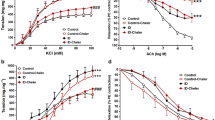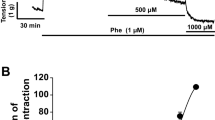Abstract
Purpose
To observe and compare the effect of taurine on contractions of aortic rings isolated from normal (NC) and insulin resistance (IR) Sprague–Dawley rats, and to explore its underlying mechanism(s).
Methods
The IR animal model was made by feeding rats with high fructose diet for 8 weeks. Aortic rings were isolated and suspended in a tissue bath, and tensions were recorded isometrically. The effects of taurine on provoked contractions of the rings were assessed in absence or presence of different potassium channel or NO-synthase inhibitors.
Results
Taurine (20–80 mM) concentration-dependently relaxed precontractions induced by KCl (30 mM) and phenylephrine (1 μM) in NC rings, but enhanced the precontractions in IR rings. Denudation of the endothelium and pretreatment with N G-nitro-l-arginine methylester ester (0.1 mM) reversed the contraction enhancement of taurine to relaxation in IR rings. Tetraethylammonium (10 mM) nearly abolished taurine-induced relaxation of NC rings, and augmented taurine-induced contraction enhancement in IR rings. Iberiotoxin (100 nM) only augmented the contraction enhancement in IR rings. 4-Aminopyridine (1 mM), glibenclamide (10 μM) and indomethacin (10 μM) had no influence on the effect of taurine in both NC and IR rings.
Conclusion
Taurine enhances contractions in IR aortic rings but relaxes the contractions in normal rat aortic ring; the enhancement is endothelium-dependent and the relaxation is endothelium-independent. TEA-sensitive K+ channel may be involved in these actions; BKCa channel dysfunction and endothelium-derived substances may be related to the contraction enhancement induced by taurine in IR aorta.





Similar content being viewed by others
References
Katakam PV, Ujhelyi MR, Miller AW. EDHF-mediated relaxation is impaired in fructose-fed rats. J Cardiovasc Pharmacol 1999;34:461–7.
Grimm JJ. Interaction of physical activity and diet: implications for insulin-glucose dynamics. Public Health Nutr 1999;2:363–8.
Navarro-Cid J, Maeso R, Perez-Vizcaino F, Cachofeiro V, Ruilope LM, Tamargo J, et al. Effects of losartan on blood pressure, metabolic alterations, and vascular reactivity in the fructose-induced hypertensive rat. Hypertension 1995;26:1074–8.
Katakam PV, Ujhelyi MR, Hoenig M, Miller AW. Metformin improves vascular function in insulin-resistant rats. Hypertension 2000;35:108–12.
Galipeau D, Arikawa E, Sekirov I, McNeill JH. Chronic thromboxane synthase inhibition prevents fructose-induced hypertension. Hypertension 2001;38:872–6.
Shinozaki K, Nishio Y, Okamura T, Yoshida Y, Maegawa H, Kojima H, et al. Oral administration of tetrahydrobiopterin prevents endothelial dysfunction and vascular oxidative stress in the aortas of insulin-resistant rats. Circ Res 2000;87:566–73.
Huxtable RJ. Physiological actions of taurine. Physiol Rev 1992;72:101–63.
Kamata K, Sugiura M, Kojima S, Kasuya Y. Restoration of endothelium-dependent relaxation in both hypercholesterolemia and diabetes by chronic taurine. Eur J Pharmacol 1996;303:47–53.
Anuradha CV, Balakrishnan SD. Taurine attenuates hypertension and improves insulin sensitivity in the fructose-fed rat, an animal model of insulin resistance. Can J Physiol Pharmacol 1999;77:749–54.
Nandhini AT, Anuradha CV. Taurine modulates kallikrein activity and glucose metabolism in insulin resistant rats. Amino Acids 2002;22:27–38.
Nandhini AT, Thirunavukkarasu V, Anuradha CV. Taurine modifies insulin signaling enzymes in the fructose-fed insulin resistant rats. Diabetes Metab 2005;31:337–44.
Franconi F, Giotti A, Manzini S, Martini F, Stendardi I, Zilletti L. The effect of taurine on high potassium- and noradrenaline-induced contraction in rabbit ear artery. Br J Pharmacol 1982;75:605–12.
Ristori MT, Verdetti J. Effects of taurine on rat aorta in vitro. Fundam Clin Pharmacol 1991;5:245–58.
Niu LG, Zhang MS, Liu Y, Xue WX, Liu DB, Zhang J, et al. Vasorelaxant effects of taurine is diminished by tetraethylammonium in rat isolated arteries. Eur J Pharmacol 2008;580:169–74.
Li N, Sawamura M, Nara Y, Ikeda K, Yamori Y. Direct inhibitory effects of taurine on norepinephrine-induced contraction in mesenteric artery of stroke-prone spontaneously hypertensive rats. Adv Exp Med Biol 1996;403:257–62.
Hwang IS, Ho H, Hoffman BB, Reaven GM. Fructose-induced insulin resistance and hypertension in rats. Hypertension 1987;10:512–6.
Karagiannis J, Reid JJ, Darby I, Roche P, Rand MJ, Li CG. Impaired nitric oxide function in the basilar artery of the obese Zucker rat. J Cardiovasc Pharmacol 2003;42:497–505.
Katakam PV, Ujhelyi MR, Hoenig ME, Miller AW. Endothelial dysfunction precedes hypertension in diet-induced insulin resistance. Am J Physiol 1998;275:R788–92.
Fulton D, Harris MB, Kemp BE, Venema RC, Marrero MB, Stepp DW. Insulin resistance does not diminish eNOS expression, phosphorylation, or binding to HSP-90. Am J Physiol Heart Circ Physiol 2004;287:H2384–93.
Baron AD, Brechtel-Hook G, Johnson A, Hardin D. Skeletal muscle blood flow. A possible link between insulin resistance and blood pressure. Hypertension 1993;21:129–35.
Steinberg HO, Chaker H, Leaming R, Johnson A, Brechtel G, Baron AD. Obesity/insulin resistance is associated with endothelial dysfunction. Implications for the syndrome of insulin resistance. J Clin Invest 1996;97:2601–10.
Shinozaki K, Ayajiki K, Kashiwagi A, Masada M, Okamura T. Malfunction of vascular control in lifestyle-related diseases: mechanisms underlying endothelial dysfunction in the insulin-resistant state. J Pharmacol Sci 2004;96:401–5.
Cook NS. Effect of some potassium channel blockers on contractile responses of the rabbit aorta. J Cardiovasc Pharmacol 1989;13:299–306.
Standen NB, Quayle JM, Davies NW, Brayden JE, Huang Y, Nelson MT. Hyperpolarizing vasodilators activate ATP-sensitive K+ channels in arterial smooth muscle. Science 1989;245:177–80.
Ogata N, Tatebayashi H. Differential inhibition of a transient K+ current by chlorpromazine and 4-aminopyridine in neurones of the rat dorsal root ganglia. Br J Pharmacol 1993;109:1239–46.
Tanaka Y, Koike K, Toro L. MaxiK channel roles in blood vessel relaxations induced by endothelium-derived relaxing factors and their molecular mechanisms. J Smooth Muscle Res 2004;40:125–53.
Brayden JE, Nelson MT. Regulation of arterial tone by activation of calcium-dependent potassium channels. Science 1992;256:532–5.
Dimitropoulou C, Han G, Miller AW, Molero M, Fuchs LC, White RE, et al. Potassium (BK(Ca)) currents are reduced in microvascular smooth muscle cells from insulin-resistant rats. Am J Physiol Heart Circ Physiol 2002;282:H908–17.
Lu T, He T, Katusic ZS, Lee HC. Molecular mechanisms mediating inhibition of human large conductance Ca2+-activated K+ channels by high glucose. Circ Res 2006;99:607–16.
Acknowledgements
This work was partly sponsored by Shanxi Provincial Fund for Guiguo Scholars, No. 200378. All authors contributed to this research and preparation of the manuscript. The authors would like to thank Li Yan for extraordinary informatics support.
Author information
Authors and Affiliations
Corresponding author
Rights and permissions
About this article
Cite this article
Xue, W., Zhang, M., Li, J. et al. Effects of Taurine on Aortic Rings Isolated from Fructose-fed Insulin Resistance Sprague–Dawley Rat are Changed. Cardiovasc Drugs Ther 22, 461–468 (2008). https://doi.org/10.1007/s10557-008-6124-9
Received:
Accepted:
Published:
Issue Date:
DOI: https://doi.org/10.1007/s10557-008-6124-9




